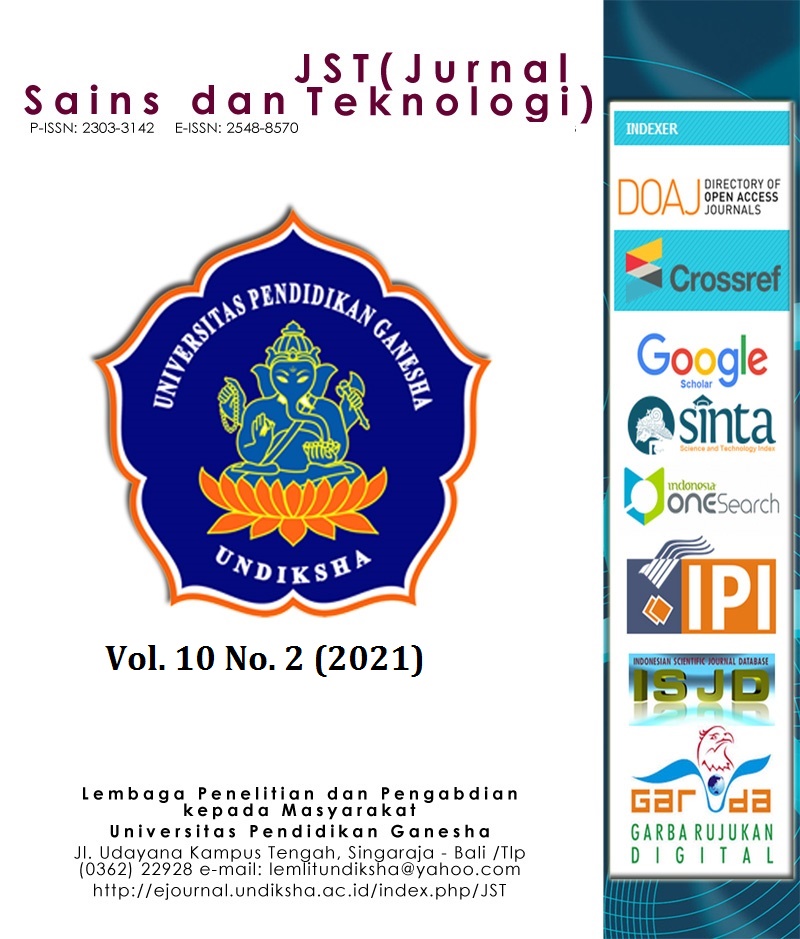PENGEMBANGAN ALAT OLAHRAGA KURSI RODA BALAP BAGI ANAK TUNADAKSA BERBASIS ERGONOMI DAN ANTROPHOMETRI
DOI:
https://doi.org/10.23887/jstundiksha.v10i2.35553Keywords:
racing wheelchair, anthropometry, ergonomicsAbstract
The purpose of the research: to develop a racing wheelchair for wheelchair racing activities for children with disabilities based on local anthropometry and ergonomics. This research is an RnD research, namely the development of media or sports equipment for children with physical disabilities. The research method used is the ADDIE method. The subjects of this study were two children with physical disabilities in SLB YPAC Surakarta. Data collection is obtained from library books, then looking for supporting paper data. After that, the data collected is analyzed, designing the development of a racing wheelchair, implementing and evaluating so that a conclusion can be drawn. Secondary data were obtained from literature books that underlie special education technology for children. Primary data is obtained from papers or journals on official websites on the internet. The data that has been collected is compiled and then analyzed, to obtain an appropriate conclusion. The results showed that children with physical disabilities need a racing wheelchair by the specifications of their needs, with high quality and affordable prices. Expert validators, practitioners, and users respond positively to the model developed through aspects of attractiveness, motivation, and convenience. The racing wheelchair design that has been developed is effective as a sporting tool for racing wheelchairs based on ergonomics and anthropometry through aspects of media convenience, display of media results and technical quality, the effectiveness of sports equipment. Conclusion: Children with physical impairment in doing sports activities need anthropometric and ergonomic local-based racing wheelchair technology.
References
Adelina, F, Akhmad, S.K & Hadi.C. (2018). Bagaimana Agar Penyandang Tunadaksa Mampu MenjadiPribadi Yang Bahagia. Jurnal Sains Psikologi, Jilid 7, Nomor 2, November, hlm 119-125.
Dewi, K.A.C, Tirtayasa.K & Handari,L.M.I.S. (2019). Sikap Kerja Lebih Ergonomis Menurunkan Gaya Kompresi Tulang Belakang dan Keluhan Muskuloskeletal serta Meningkatkan Produktivitas. Jurnal Ergonomi Indonesia, Vol.05. No.02 : Juli-Desember, ISSN Print : 1411 – 951 X, ISSN Online : 2503-1716.
Harahap, Repindowaty.R & Bustanuddin. (2015). Perlindungan Hukum Terhadap Penyandang Disabilitas Menurut Convention On The Rights Of Persons With Disabilities (CRPD). Jurnal Inovatif, Vol. III, No. 1, Januari
Harahap, P, Huda.L.N & Pujangkoro.S.A. (2013). Analisis Ergonomi Redesain Meja Dan Kursi Siswa Sekorah Dasar. E-Jumal Teknik Industri FT USU Vol 3, No. 2, Oktober 2013 pp. 38-44. Departemen Teknik Industri, Fakultas Teknik, Universitas Sumatera Utara.
Iridiastadi, H. (2017). Ergonomi Suatu Pengantar. Bandung: PT. Remaja Rosdakarya.
Leksono, et al. (2010). The Influence of Urban Accessibility in Determining Average Indicated Land Values for the Region. The XXIV FIG International Congress 2010 Proceeding. Diakses dari https://www.fig.net/resources/proceedings/fig_proceedings/fig2010/paper s/ts10f/ts10f_susilowati_leksono_et_ al_4317.pdf.
Nusantara, A.F.P & Batan.I.M.L. (2018). Perancangan Multipurpose Wheelchair. Nusantara A. F. P., Jurnal ROTOR, Volume 11 Nomor 2, November..
Praviasari, A. & Wardoyo, A. (2012). Meja Mandiri Siswa untuk Interior Sekolah DasarLuar Biasa YPAC Surabaya bernuansa modernJURNAL TEKNIK POMITSVol. 1, No. 1, 1-5.
Suhardi, B, Laksono, P.W & Minarto.Y.T. (2013).Redesain Shelter Bus Trans Jogja Dengan Pendekatan Anthropometri Dan Aksesibilitas.Jumal Ilmiah Teknik Industri, Vol. 12, No. 2, Desember ISSN 1412-6869.
Utami, E.O, Raharjo, S.T & Apsari, N.C. (2018). Aksesibilitas Penyandang Tunadaksa.Jurnal Penelitian & PPM, Vol 5, No: 1, April ISSN: 2442-448X.
Widi, N.A& Nirwansyah, R. (2013).Penerapan Aksesibilitas pada Desain Fasilitas Sekolah Luar Biasa.Jurnal Sains Dan Seni Pomits : Arsitektur, Fakultas Teknik Sipil dan Perencanaan, Institut Teknologi Sepuluh Nopember (ITS).
Yusuf, M. (2018). Pendidikan Inklusif Dan Perlindungan Anak. Surakarta: Tiga Serangkai.
Downloads
Published
How to Cite
Issue
Section
License
Authors who publish with the Jurnal Sains dan Teknologi (JST) agree to the following terms:
- Authors retain copyright and grant the journal the right of first publication with the work simultaneously licensed under a Creative Commons Attribution License (CC BY-SA 4.0) that allows others to share the work with an acknowledgment of the work's authorship and initial publication in this journal.
- Authors are able to enter into separate, additional contractual arrangements for the non-exclusive distribution of the journal's published version of the work (e.g., post it to an institutional repository or publish it in a book), with an acknowledgment of its initial publication in this journal.
- Authors are permitted and encouraged to post their work online (e.g., in institutional repositories or on their website) prior to and during the submission process, as it can lead to productive exchanges, as well as earlier and greater citation of published work. (See The Effect of Open Access)
















